Digital Library of Zielona Góra contains 9 272 digital objects
Object
Title: Gdzie te dzieci? O pronatalistycznej (nie)efektywności programu "Rodzina 500 plus" = Where are the children? On the pronatalistic (non)effectiveness of the "Family 500 plus" programme
Contributor:
Nowak, Beata Maria - red. ; Paprzycka, Emilia - red. ; Narkiewicz-Niedbalec, Ewa - red.
Group publication title:
Abstract_pl:
Od trzech dekad wskaźnik dzietności w Polsce utrzymuje się poniżej poziomu prostej zastępowalności pokoleń, a długoterminowe prognozy demogra?czne nie zapowiadają rychłej poprawy w tym obszarze. Podejmowane w ostatnich latach w ramach polityki prorodzinnej działania okazały się mało efektywne. Dotyczy to również wprowadzonego w 2016 roku programu "Rodzina 500+". Po początkowym wzroście wskaźnika dzietności w latach 2016-2017, ponownie nastąpił jego spadek. ; W artykule podjęto próbę odpowiedzi na pytanie, dlaczego program, de?niowany jako pronatalistyczny, mimo zapowiedzi jego twórców, nie przynosi oczekiwanych rezultatów. Analizując przyczyny tego zjawiska, uwzględniono zarówno uwarunkowania demogra?czne, wynikające m.in. z malejącej liczebności kobiet w wieku rozrodczym, jak również czynniki społeczno-kulturowe, w tym będące efektem drugiego przejścia demogra?cznego, zmiany w realizowanych modelach rodziny i dzietności, które znajdują odzwierciedlenie w preferencjach i postawach wobec prokreacji.
Abstract:
For three decades, the fertility rate in Poland has been below the level of simple replacement of generations, and long-term demographic forecasts do not indicate any immediate improvement in this respect. The measures taken in recent years as part of a pro-family policy have proved to be ine?ective. This also applies to the "Family 500+" programme introduced in 2016. After an initial increase noted between 2016 and 2017, the fertility rate dropped again. ; The article attempts to answer the question as to why the programme, de?ned as a pronatalistic one, does not yield the expected results despite the announcements of its creators. The analysis of the causes of this phenomenon takes into account both demographic conditions, resulting from the decreasing number of women of reproductive age, and socio-cultural factors, including those resulting from the second demographic transition, changes in family and fertility models, which are re?ected in preferences and attitudes towards procreation.
Publisher:
Zielona Góra: Lubuskie Towarzystwo Naukowe
Format:
Resource Identifier:
DOI:
Pages:
Source:
Rocznik Lubuski, tom 46, część 2
Language:
Rights:
Biblioteka Uniwersytetu Zielonogórskiego
Object collections:
- Repository > Faculties > Faculty of Education, Psychology and Sociology
- Repository > Types of work > Articles
- Repository > Scientific journals and UZ publishing series > Lubuski Yearbook
Last modified:
Jul 3, 2024
In our library since:
Jun 27, 2024
Number of object content hits:
145
All available object's versions:
https://zbc.uz.zgora.pl/repozytorium/publication/89457
Show description in RDF format:
Show description in OAI-PMH format:
Objects Similar
Turkowska-Kucharska, Wioleta Zielińska, Maria - red.
Prostak, Rafał
Kaźmierczak-Kałużna, Izabela Leszkowicz-Baczyńska, Żywia - red.
Kaźmierczak-Kałużna, Izabela Pokrzyńska, Magdalena - red. Nowicka, Ewa - red.
Kaźmierczak-Kałużna, Izabela Frątczak-Müller, Joanna - red. Mielczarek-Żejmo, Anna - red. Szczegóła, Lech - red.
Bazuń, Dorota Kaźmierczak-Kałużna, Izabela Pokrzyńska, Magdalena Łuczkiewicz, Roman Wojciech - wsp. Związek Sybiraków. Koło Nr 8 (Zielona Góra)

